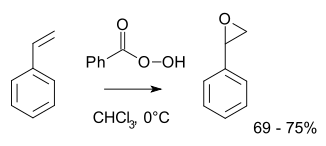Styrene oxide
Styrene oxide is an epoxide derived from styrene. It can be prepared by epoxidation of styrene with peroxybenzoic acid, in the Prilezhaev reaction:[1]
 | |
| Names | |
|---|---|
| Preferred IUPAC name
2-Phenyloxirane | |
| Other names
Phenyloxirane; Epoxystyrene; Styryl oxide; Phenylethylene oxide | |
| Identifiers | |
3D model (JSmol) |
|
| ChEBI | |
| ChemSpider | |
| ECHA InfoCard | 100.002.252 |
| KEGG | |
PubChem CID |
|
| UNII | |
CompTox Dashboard (EPA) |
|
| |
| |
| Properties | |
| C8H8O | |
| Molar mass | 120.151 g·mol−1 |
| Appearance | Colorless to light yellow liquid |
| Density | 1.052 g/mL |
| Melting point | −37 °C (−35 °F; 236 K) |
| Boiling point | 194 °C (381 °F; 467 K) |
| Hazards | |
| Safety data sheet | Oxford University MSDS |
EU classification (DSD) (outdated) |
Harmful (XN); Corrosive (C) |
| R-phrases (outdated) | R20 R22 R34 R36 R37 R38 |
Except where otherwise noted, data are given for materials in their standard state (at 25 °C [77 °F], 100 kPa). | |
| Infobox references | |

Styrene oxide is slightly soluble in water. A trace amount of acid in water causes hydrolysis to racemic phenylethyleneglycol via aryl cation. If the amount of water is not sufficient, acid-catalyzed isomerization for phenylacetaldehyde will occur.[2]
Styrene oxide in the body is metabolized to mandelic acid, phenylglyoxylic acid, benzoic acid and hippuric acid.
Hydrogenation of styrene oxide affords phenethyl alcohol.[3]
Stereospecific reaction
Since styrene oxide has a chiral center at the benzylic carbon atom, there are (R)-styrene oxide and (S)-styrene oxide. If optically pure reagent is used, only one optically pure compound will be obtained.
Toxicology
Styrene oxide is a main metabolite of styrene in humans or animals, resulting from oxidation by cytochrome P450. It is considered possibly carcinogenic from gavaging significant amounts into mice and rats.[4] Styrene oxide is subsequently hydrolyzed in vivo to styrene glycol by epoxide hydrolase.[5]
Styrene oxide has a chiral center and thus two enantiomers. It has been reported that the two enantiomers had different toxicokinetics and toxicity. It was reported that the (R)-styrene oxide was preferentially formed in mice, especially in the lung, whereas the (S)-styrene oxide was preferentially generated in rats. In human volunteers, the cumulative excretion of the (S)-enantiomer of styrene glycol and mendelic acid were higher than the R form after exposure to styrene. In human liver microsomes, cytochrome P450-mediated styrene oxidation showed the production of more S enantiomer relative to the R enantiomer. It was also found that (S)-styrene oxide was preferentially hydrolyzed than the R enantiomer in human liver microsomes. Animal studies have shown that the (R)-enantiomer of styrene oxide was more toxic than the (S)-enantiomer in mice.
References
- Harold Hibbert and Pauline Burt (1941). "Styrene Oxide". Organic Syntheses.; Collective Volume, 1, p. 494
- Verfahren zur Herstellung von Phenylacetaldehyde, BASF-Patent DE3546372A1 vom 2. Juli 1987
- Fahlbusch, Karl-Georg; Hammerschmidt, Franz-Josef; Panten, Johannes; Pickenhagen, Wilhelm; Schatkowski, Dietmar; Bauer, Kurt; Garbe, Dorothea; Surburg, Horst (2003). "Flavors and Fragrances". Ullmann's Encyclopedia of Industrial Chemistry. doi:10.1002/14356007.a11_141. ISBN 978-3-527-30673-2.
- EPA Styrene Oxide evaluation
- Kenneth C. Liebman (1975). "Metabolism and toxicity of styrene" (PDF). Environmental Health Perspectives. 11: 115–119. doi:10.2307/3428333. JSTOR 3428333.